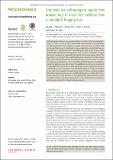Grey seals use anthropogenic signals from acoustic tags to locate fish : evidence from a simulated foraging task
Abstract
Anthropogenic noise can have negative effects on animal behaviour and physiology. However, noise is often introduced systematically and potentially provides information for navigation or prey detection. Here, we show that grey seals (Halichoerus grypus) learn to use sounds from acoustic fish tags as an indicator of food location. In 20 randomized trials each, 10 grey seals individually explored 20 foraging boxes, with one box containing a tagged fish, one containing an untagged fish and all other boxes being empty. The tagged box was found after significantly fewer non-tag box visits across trials, and seals revisited boxes containing the tag more often than any other box. The time and number of boxes needed to find both fish decreased significantly throughout consecutive trials. Two additional controls were conducted to investigate the role of the acoustic signal: (i) tags were placed in one box, with no fish present in any boxes and (ii) additional pieces of fish, inaccessible to the seal, were placed in the previously empty 18 boxes, making possible alternative chemosensory cues less reliable. During these controls, the acoustically tagged box was generally found significantly faster than the control box. Our results show that animals learn to use information provided by anthropogenic signals to enhance foraging success.
Citation
Stansbury , A , Götz , T , Deecke , V B & Janik , V M 2015 , ' Grey seals use anthropogenic signals from acoustic tags to locate fish : evidence from a simulated foraging task ' , Proceedings of the Royal Society B: Biological Sciences , vol. 282 , no. 1798 , 20141595 . https://doi.org/10.1098/rspb.2014.1595
Publication
Proceedings of the Royal Society B: Biological Sciences
Status
Peer reviewed
ISSN
0962-8452Type
Journal article
Description
This study was conducted under Home Office licence number 60/33030. This study was funded by the Natural Environment Research Council of the UK, grant no. NE/I024682/1.Collections
Items in the St Andrews Research Repository are protected by copyright, with all rights reserved, unless otherwise indicated.

